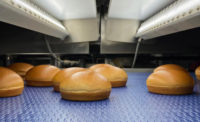Distribution strategies for snack and bakery companies
Direct store delivery, third-party logistics often popular with snack manufacturers.

Courtesy of Alpha Baking Co.
The Bottom Line:
- Direct store delivery challenges
- Growing fulfillment
- Debuting smartphone apps
There are many options for snack and bakery companies when it comes to distribution. Companies can employ different strategies, such as direct store delivery (DSD), third-party logistics (3PL), or using foodservice. In the end, though, what matters is getting product into customers’ hands.
Direct store delivery
DSD, or delivering products from a supplier or distributor directly to a store, also known as skipping the retailer’s distribution center, is a common practice used by snack and bakery companies.
“Here in the greater Cincinnati area, we service anywhere from 90 to about 130 different accounts monthly, that we deliver from our vehicle,” says Brady DeLong, COO, Hen of the Woods, Cincinnati, OH.
“We manage that through a platform called BlueCart. [The platform] was originally created for restaurants to be able to source their products and for distributors and small brands, such as ours, to sell products into restaurants. It has evolved into a tool; it's a little more robust, and it has quite a handful of various features. It has route planning, different pricing catalogs for accounts, etc. We are using that platform to deliver five days a week currently, so it's a myriad of accounts: foodservice, coffee shops, grocery,” he says.
“BlueCart is the platform we use for all of our local direct distribution. Outside of the greater Cincinnati area, we ship everything via UPS, and we use a handful of different platforms for that. These are more B2B marketplaces, such as Faire, Mable, RangeMe,” DeLong continues.“There’s a handful of other smaller ones, but those are the three primary ones, and through that distribution some of them have shipping platforms built in, but [some] do not. We are using ShipStation as our primary platform for shipping those products.”
DeLong says that the company has become more efficient over the years.
“At one point in time we were actually DSD to 62 Kroger stores, so that required us to learn a lot about the process, creating a lot of systems and giving them support—we had three vehicles that we had created and all types of connected Google Sheets for inventory reporting. These days, our biggest growth is actually in the direct ship and in the B2B ecommerce that we are shipping to via UPS. So the efficiency is there, as that has grown almost 1,000% year over year for us—we used to ship maybe four to 15 cases a week, about a year ago, and now we are shipping about 30 cases a day. It’s evolved quite a lot,” he says.
Hen of the Woods rearranged its warehouse to become more of a shipping fulfillment warehouse, DeLong notes.
“[We] moved a lot of products around, had to buy some more materials, and then we had to modify our pack sizes to be more economically sustainable for us—shipping the pack sizes that we were selling in retail. We're not optimized for a price per unit shipping model,” he explains.
“So we have changed the case packs, [trying] to balance it the best we could between what's affordable for us as a brand, and what's appealing for retailers. It's hard to sell 100-count cases because people don't want to buy 100 of a single item. There's definitely a fine line that we want there, and we do have some flexibility with being able to order like case packs or mixed packs and things along those lines,” DeLong adds.
“We started selling a sampler pack on a lot of these marketplaces that allow potential customers to purchase their samples at a discount rate for first-time customers. That helps us offset the new customer acquisition cost, and it's an appealing way for new retailers to get products in their hands and try our chips,” he explains.
New technologies
Bill Houston, vice president, information technology & administrative services, executive, Alpha Baking Co., Chicago, says that from the perspective of technology, the company developed an algorithm a few years ago that helped it dial in usage at a particular customer location.
“[The algorithm] combined the data we had available to us, along with some additional data points we ask drivers to collect. The idea here was to give us a forecast that was true to our customer needs. Without getting too deep into the ‘secret sauce,’ this is no strict average order—the algorithm is quite sophisticated,” he comments.
“Customers like the flexibility of ordering as close to required lead times as possible, for obvious reasons. This technology allowed us to continue offering this high level of service, while still providing our production teams highly accurate production forecasts, reducing waste and shortages at the same time,” Houston notes.
“More recently, we have developed a smartphone and web-based application that allows our customers to place their orders from anywhere, at any time. Our hold times for our call center have always been an area of focus, but during periods of peak demand, brief holds are inevitable. With our ordering app, a customer can bypass our call center entirely and place an order on their own terms, as long as it meets lead-time requirements. The same goes for viewing invoices and making payments,” he says.
The challenge is always meeting the customer where they are from a tech perspective, Houston adds, combined with the fact that the industry operates on short lead times as well as short shelf life.
“The latter are constants when it comes to challenges in our industry—the balance of service and quality. There is no one size fits all answer; we have to be cognizant of where things are going, recognizing that for many, where we are is just fine. Marrying customer service and technology can prove difficult, but it’s a worthwhile exercise we are constantly undertaking.”
Challenges and solutions
DeLong says one of Hen in the Woods’ biggest challenges is scaling fulfillment.
“We're kind of at a tipping point where we're almost where we need another full-time fulfillment [employee]—we’re maxing out our current fulfillment person's time, and we look at going to a 3PL, but we also really like the idea of employing more people ourselves,” he explains.
“We like to think we take care of our people pretty well, so we want to keep those people on staff, and our customer service is one of the things [on which] that we really pride ourselves. Handling fulfillment off to a 3PL [would be] one less thing we have control over, so we've tried to avoid that,” DeLong shares.
DeLong notes that DSD is a high-profit margin for the company, and the company loves it because it builds a direct relationship with vendors.

“We've talked about expanding DSD to our neighboring cities. We're about an hour south of Dayton, which is a pretty good-sized market, and we're about an hour and 40 minutes southwest of Columbus, which is one of the top 15 largest cities in the U.S. We have a very formidable presence in the Columbus market with Kroger, Whole Foods, Giant Eagle, and Market District,” he comments.
“That would definitely present some challenges; but right now, UPS has been a good enough distribution partner for us, and pretty much in the whole region. Everything is almost Next Day [delivery] so it's actually better than what they'd get if they were purchasing through a distributor,” DeLong expands.
“Right now we're at the tipping point—if we grow a little bit more in fulfillment, we'll need to hire another individual, and then [we would need to] fulfill a lot more to cover that expense. We’re trying to weigh the pros and cons, and figure out what things we've been outsourcing that maybe we bring back-in house. That individual can maybe take some things off our key operators’ plates, like my plate, and our [employee] that does all of our operations and finance,” he adds.
“So managing the personnel around that has not been a challenge, but as it grows it will start to be something that is going to be a problem that we're going to have to solve.” SF&WB
Looking for a reprint of this article?
From high-res PDFs to custom plaques, order your copy today!








